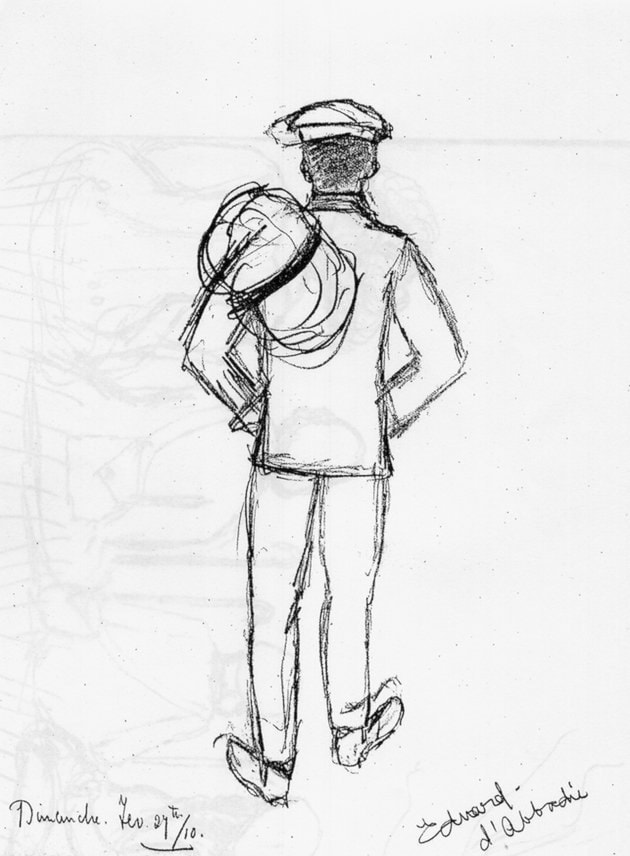This is the story of Bryan Mahon’s grandmother, told in five installments.
The children grew up under Elizabeth’s guidance. She wanted to ensure that her girls were prepared for life by cultivating their creative abilities. She joined several other mothers in asking Emily Carr to give their children art lessons on Saturday mornings. Both Gundrid and Lilette attended, but it was Lilette who flourished under the mentorship.
To round out their education, the girls were sent to France in 1909 in the company of aunt Adele d’Abbadie for a two year stay with their cousins. Jules died in Haiphong in 1904 and his widow Clementine had returned to France with their children. She married a naval officer, a Doctor Varenne, who maintained a household at Lorient, in Brittany. While there, Lilette continued to paint as she tried to rationalize the advances of a much older suitor, Edward Mahon, whom she greatly admired, with her natural attraction to a much younger cousin, also named Edouard. She wrote to her mother dutifully:
February 20: … As usual, on Sunday afternoon it is blowing a gale and raining. It must be very bad weather at sea, a lot of seagulls are flying over the garden. …
Thursday was Edouard’s birthday. I painted him a book cover in linen lined with soft green satin. Gundrid made him a box for his ties. He is seventeen. …
Just think, a month from today I will be twenty one. It is an old age approaching. I am unhappy to think there is so little to show for all these years.
Elizabeth by this time was a published author of two books with intimidating subtitles: The Home of the Dragon: A Tonquinese Idyll, Told in Seven Chapters whose author was listed as Anna Catharina (her nom de plume); and The Stragglers: A Tale of Primal Asperities, with Elizabeth Rebbeck as the name of the author. The latter work presents vignettes of pioneering life in British Columbia.
The idyllic life in Brittany was shattered two months later when the children were recalled home to be at the bedside of their gravely-ill father:
My beloved children,
This letter is going to bring sorrow to your dear loving hearts, but battle as I may, I cannot keep from you any longer that your darling father is still very ill. I had hoped that things would change for the better and that I would have had the joy of sending a better report, but time is passing and we are too far apart to keep in daily touch. So you must be brave and loving to one another and try to understand what I am going to tell you.
Our darling daddy has had for some time what we thought was a bad cold, but it not apparently getting any better under treatment, Dr. Jones proposed an examination. … Dr. Jones found a stricture in the gullet (a sort of malformation) which causes the trouble and prevents him from swallowing. … We came to the hospital yesterday and Dr. Jones performed an operation on the stomach which will help him get better. …
You must come and help me nurse him back to health if possible. …
The oesophageal cancer was a death sentence in those days, and James died on Sept. 1, 1910. Edward Mahon immediately came to the rescue. He and James had been good friends and he held stock in Albion Iron Works. He offered Elizabeth a new home and a job at the Capilano Suspension Bridge, which he was at the time acquiring. He hired an architect to improve George Mackay’s Cliff House, located at the edge of the canyon, so it would be a suitable residence for Elizabeth and her family. By October the renovations were complete and Elizabeth and Lilette moved in, along with three Japanese servants. Gundrid and Waller remained at Victoria to attend boarding school. A month later, a baby girl was born to Yui-san, increasing the resident numbers to six.
Early in 1911 Edward approached his business associate William Farrell to build him a tea house nearer to the suspension bridge. When it was completed, Elizabeth launched herself on a mission to formally landscape the adjacent grounds with the help of her Japanese servants. She had considerable experience in the field and had managed a seed export business in Indochina. Edward depended on her connections when he started importing plants from the Orient for landscaping at various locations, which included his Oriental cottage that was constructed by Japanese craftsmen at the same time on property he had purchased on the west side of the Capilano River.
To be continued
Walter Volovsek’s website can be found at trailsintime.org
Previous installments in this series
Macao to Capilano: A Life Journey, Part 2
Macao to Capilano: A Life Journey, Part 1
The Old Glory weather observatory
David Thompson: Mapping our region
Reappraising the Franklin Expedition
Connecting with Albert McCleary
Lilette Mahon: A mentor’s gift
Edward Mahon: Searching for a legacy
Edward Mahon: A stimulating childhood
Intrigues: Castlegar’s lacklustre childhood
Perceptions: Adrift on the River of Life
